 When multiplying decimals, remember that the number of decimal places in the product must be equal to the sum of the number of decimal places in the numbers being multiplied. When multiplying decimals, remember that the number of decimal places in the product must be equal to the sum of the number of decimal places in the numbers being multiplied.  Arithmetic - Page 103by A G. Blake - 1885Full view Arithmetic - Page 103by A G. Blake - 1885Full view - About this book
 | James Hamblin Smith - 1872 - 136 pages
...deduce the following rule for Multiplication of Decimals. Multiply as in the case of integers, and mark off in the product a number of decimal places equal...to the sum of the number of decimal places in the two factors. For example, to multiply 2-4327 by 4'23. 2-4327 4-23 ~72981 48654 97308 10-290321 147.... | |
 | Education - 1926 - 682 pages
...— no matter how, just place it — and proceed as in simple multiplication. In the result, mark off a number of decimal places equal to the sum of the number of such places in the multiplier and multiplicand. Such a proceeding is sheer rule of thumb; for in none... | |
 | John Henry Moore - Business mathematics - 1904 - 404 pages
...the following rule is derived : Multiply as in whole numbers. From the right in the product point off a number of decimal places equal to the sum of the number of decimal places in the multiplicand and multiplier. WRITTEN EXERCISE 1. .52 x. 25x0x95 = ? 4. 25000 x .000024 = ? 2. 1625.426... | |
 | Education - 1911 - 658 pages
...State reasons for approval or disapproval. Annwers. 1. Make the number of decimal places in the product equal to the sum of the number of decimal places in the factors. By changing the decimals to common fractions the reason for the rule is readily Keen. 2. 25* of $3.60... | |
 | Michigan. Department of Public Instruction - Accidents - 1916 - 220 pages
...decimals. A device for obtaining the position of the decimal point must be obtained. This device is, "Point off in the product a number of decimal places equal to the sum of the decimal places in multiplier and multiplicand." That this gives the correct location of the decimal... | |
 | Eugene Henry Barker - Mathematics - 1920 - 264 pages
...11. 22. 23. 24. 12 ia. Multiplication of Decimals Rule. — To multiply one decimal by another, point off in the product a number of decimal places equal...to the sum of the number of decimal places in the multiplicand and multiplier. EXAMPLE 1. Multiply 4.3 by .6. 4.3 .6 2.58 EXAMPLE 2. Multiply .38 by... | |
 | 1923 - 364 pages
...Numbers To multiply decimal numbers by decimal numbers, multiply as with ordinary numbers and point off in the product a number of decimal places equal...to the sum of the number of decimal places in the multiplier and the multiplicand. Multiply. 1. 9.7 8.5 2. 14.8 7.4 3. 4. 25.16 5.8 41.4 3.76 5. 6. A.... | |
 | A. S. Kalra - Juvenile Nonfiction - 1995 - 302 pages
...you can remember the following rule. "The number of decimal places in the product of two decimals is equal to the sum of the number of decimal places in the two numbers being multiplied". In other words, you can temporarily forget the decimal point and simply... | |
 | A. S. Kalra - Mathematics - 1998 - 246 pages
...you can remember the following rule. "The number of decimal places in the product of two decimals is equal to the sum of the number of decimal places in the two numbers being multiplied". In other words, you can temporarily forget the decimal point and simply... | |
 | Alex Greer, Clarrie Layne - Juvenile Nonfiction - 2001 - 498 pages
...in the two numbers that are multiplied. In each case the number of decimal places in the product is equal to the sum of the number of decimal places in the two numbers. Thus in (b) the number 25 contains 0 decimal places, while 0.5 contains one decimal place.... | |
| |